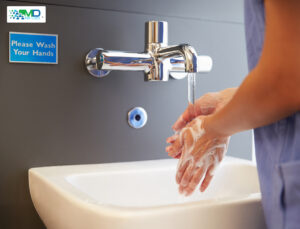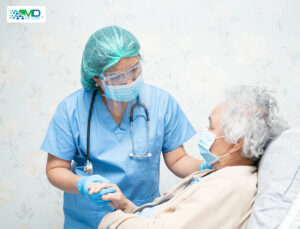Infection control and patient safety go hand in hand, and together they are the backbone of high-quality healthcare. Whether you are a radiology technician, a respiratory therapist, or a lab professional, you are not just treating patients but also safeguarding them from preventable harm, especially Healthcare-Associated Infections (HAIs).Now, with the world trying to recover from the weight of COVID, infection prevention and control (IPC) practices have taken on new urgency. According to the World Health Organization, 1 in every 10 patients receiving hospital care suffers some sort of harm, while from 5% to 15% of hospitalized patients in low and middle-income countries, on average, acquire at least one HAI.
On the front line and in direct contact with people, highly trained and Allied Healthcare Professionals (AHPs) work in some of the highest-risk environments. This blog explores the latest infection control and patient safety trends that every AHP should know – practical, evidence-based practices that are reshaping infection control and patient safety, from AI surveillance to UV disinfection. This is how patient safety and infection control are transforming today.
Latest Infection Control and Patient Safety Trends
Clean Hands, Safer Patients: The Evolution of Hand Hygiene

Let’s talk about clean hands as one of the simplest yet strongest defenses. The WHO’s ‘5 Moments for Hand Hygiene’ remains a standard across the world, but compliance is uneven. Lately, several studies include the use of behavioral science-informed interventions with digital monitors for better health and safety infection control.
Digital hand hygiene monitoring systems such as BioVigil and DebMed are gaining credence. The systems use sensors and badges to track real-time compliance and provide feedback and nudges to improve compliance. According to a 2022 study, adherence rates could improve by up to 30% with these systems.
For AHPs, hand hygiene is not merely a commitment; it is a fundamental responsibility. During the entire process, from patient preparation to equipment cleaning, every point of contact counts. Alcohol-based hand rubs may now be considered the preferred method over regular soap for most instances, unless there is visible soil on the hands.
Pro tip: Always keep pocket sanitizers and participate in compliance training on a regular basis, as studies have shown that peer-led reinforcement results in great improvements in hand hygiene practices.
Fighting Resistance, One Prescription at a Time
Antimicrobial resistance (AMR) is not only a headache for physicians; it is everyone’s problem, and it is one that constantly grows. The CDC indicates that more than 2.8 million antibiotic-resistant infections occur in the United States every year.
The Antimicrobial Stewardship Programs (ASPs) are primarily composed of interprofessional teams, including the likes of pharmacists, nurses, and, more recently, AHPs. Such programs work to ensure that the right drug, right dose, and right duration are used against infections.
Early studies show pharmacist-led stewardship programs led to measurable success, including a 15% reduction in antibiotic use and a 20% reduction in C. difficile infections.
As an AHP, you can:
- Report suspected side effects or ineffectiveness early.
- Avoid pressuring clinicians for unnecessary prescriptions.
Respiratory therapists play a key role in preventing ventilator-associated pneumonia, but they still need support and training to fully align with updated protocols.
Use of Technology and AI in Infection Control
Technology is rapidly rewriting the infection control and patient safety rulebook. The manual cleaning-based methods and reports are in the past. Hospitals are today more technologically advanced with AI-based instrumentation and smart disinfection technologies to gain the edge over infection control safety.
Deployment of UV-C disinfection robots, Tru-D and Xenex, in the ORs and patient rooms lowers the bioburden. According to the American Journal of Infection Control, UV-C devices can lower the rates of multidrug-resistant organisms (MDROs) by 25%.
Infection surveillance platforms driven by AI, such as VigiLanz and MedMined, are also rising. This type of surveillance platform tracks patient data in real time, flagging infection patterns and outbreaks much quicker than the traditional system.
For AHPs, familiarity with such tools is essential. Training modules are increasingly available to help you:
- Operate or coordinate with UV tools during cleaning.
- Interpret dashboard alerts related to infection metrics.
- Report anomalies for early response.
High-Risk, High-Precision: Infection Prevention in Critical Procedures
The reality is that invasive procedures are high-risk areas for infection regardless of whether a catheter is being inserted, blood drawn, or a ventilator adjusted. The implementation of new safety bundles and checklists is now standard practice for essential issues like CLABSIs (central line-associated bloodstream infections) and CAUTIs (catheter-associated urinary tract infections).
Radiology techs and lab professionals are critically instrumental in minimizing these risks. Proper aseptic techniques and adherence to PPE protocols cannot be overstated. Safety checklists like these in aviation have been shown to reduce surgical site infections by more than 30% in some hospitals.
Key takeaway for AHPs:
- Stick to sterile field protocols.
- Double-check patient prep procedures.
- Advocate for retraining if you observe outdated practices.
Mastering Clean Spaces to Minimize Hidden Risks
Infection can find its silent reservoir in the surfaces of hospitals, where pathogenic organisms can survive for days, if not weeks. As a result, healthcare facilities are moving towards next-generation EPA-approved disinfectants with sustainable antimicrobial activity: sprays based on hydrogen peroxide and quaternary ammonium compounds. As noted in an article on Galileo Search, many institutions have embraced the use of electrostatic sprayers that can ensure uniform and effective coverage of disinfectants on all surfaces.
In high touch zones these days, the likes of bed rails, monitors, and door handles are disinfected not merely once or twice but multiple times each day and often audited through digital compliance tools to ensure adherence and timing. The overarching message is clear: environmental hygiene is no longer negotiable – it is mission critical.
AHPs working within shared care environments are vital in infection prevention beyond the bedside. Safety in these environments requires AHPs to:
- Keep the workstation clean, especially before and after contact with the patient.
- Educate patients on good hygiene practices within the waiting areas, diagnostic rooms, and treatment areas.
- Hold daily huddles to review environmental safety within the team, reiterate work practices, and discuss any issues.
A piece of advice: Implement simple surface disinfection checklists in departments. It boosts accountability and, research shows, it enhances safety and quality infection control across shifts.
Creating a Culture Where Every Voice Matters
Culture drives behavior. In high-pressure health-care environments, everyone must feel protected so that any AHP can speak up regarding unsafe practices or lapses.
SBAR (Situation, Background, Assessment, Recommendation) communication is widely used today for the clear communication of critical information – especially during patient handoffs or shift changes. Multidisciplinary rounds, another growing trend, promote open dialogues to allow for a team-based approach to infection control.
Establish a culture in which every voice is heard. Encourage juniors to question and seniors to mentor the juniors not only in medicine but also in ethical behavior.
Staying Informed to Deliver Safer Patient Outcomes
Changes in infection prevention scenarios are unwarrantedly increasing the demand for corresponding alterations. As far as the present scenario is concerned, a whole lot of flexible and accessible training methods exist-from internet simulations to brief micro-modules.
Several states in the US and some countries globally have mandated annual IPC training for license-renewal purposes. There are even free certification courses for anyone wishing to understand the basics of IPC offered on platforms like Coursera and Medscape.
Some hospitals are putting together VR technology for training sterile techniques that are more stimulating, interactive, immersive design, and gaming-type courses, with outcomes that are superior when compared to standard lecturing. For AHPs, this is important not only for career growth but also from the standpoint of infection prevention and patient safety.
Protecting Patients Starts with You Staying Prepared

Infection control and patient safety is not a one-time event but rather a daily claim. For AHPs, it is an everyday mission, whether it is to lead better hygiene practices, adopt clever technology, or create pathways of seamless communication with other colleagues.
Are you an AHP passionate about improving patient outcomes? Join the MDForLives to share your insights, stay ahead of clinical trends, and earn through paid medical surveys. Your expertise matters – let it be heard, valued, and celebrated.
Also read about
Scope of Bariatric Surgery Trend
FAQs
What are the new technologies in infection control?
Among the latest technologies that are changing scenarios for infection control are AI-assisted surveillance systems, UV-C disinfection robots, and digital hand hygiene monitors.
What are the 5 F’s of infection control?
The 5 F’s are fingers, feces, fluids, food, and fomites (objects/surfaces); all of these are major transmission vehicles for infectious agents.
What is infection control and safety?
Infection control is applicable to all measures designed for prevention and control of infections in healthcare settings, while safety pertains to protecting patients from any form of harm, including safety from HAIs.
What are 5 infection control practices?
The 5 core infection control practices are:
Proper hand hygiene
Consistent use of Personal Protective Equipment (PPE)
Sterilization of medical equipment
Routine environmental cleaning
Safe injection techniques

MDForLives is a vibrant community of healthcare professionals and patients dedicated to shaping the future of healthcare. We provide valuable global insights to healthcare companies through online surveys, interviews, and discussion forums.






